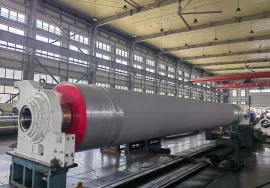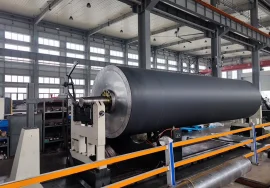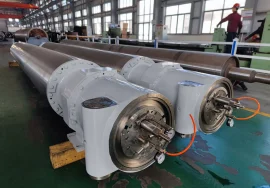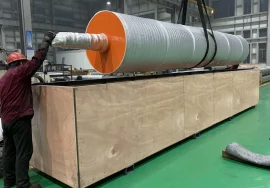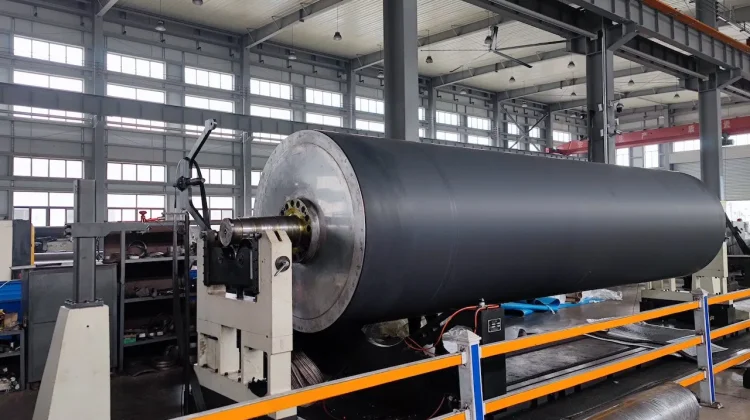
Understanding Paper Machine Rolls: Types and Functions Explained
When you hold a sheet of paper, whether it’s for writing, printing, or packaging, you’re interacting with a product that has undergone a complex transformation. At the heart of this transformation is the paper machine, a marvel of engineering efficiency. And within this intricate machinery, no components are perhaps more critical, or more numerous, than the paper machine rolls. To be honest, these rolls are far more than just simple cylinders; they are precision-engineered instruments, each designed for specific tasks within the paper manufacturing process. Their proper functioning is absolutely vital to the quality, efficiency, and speed of paper production. Understanding these rolls – their various types and the distinct functions they perform – is fundamental to appreciating the mechanics behind paper creation. They guide the paper web, remove water, press fibers, smooth the surface, and much more, acting as the silent workhorses of the mill.
Interestingly enough, the sheer variety of rolls required in a modern paper machine can be astounding. From the initial stages where the wet pulp web is formed, through pressing and drying sections, right up to the final calendering and winding, different rolls are employed, each tailored to the conditions and requirements of that specific stage. The materials they are made from, their surface coatings, internal structures, and even their size and weight, are all carefully selected and engineered. Frankly speaking, without the right roll performing its designed function at the correct point in the process, the resulting paper would be substandard, or perhaps wouldn’t even hold together. This article aims to pull back the curtain and explain just what these rolls are, how many different kinds exist, and precisely what roles they play in turning a watery slurry of fibers into the finished paper product we rely on daily. Let’s delve into the essential world of paper machine rolls.
Understanding the Foundational Role and Impact of Paper Machine Rolls
At its core, a paper machine is a continuous process line, and rolls are the elements that facilitate the movement and transformation of the paper web as it travels from the wet end to the dry end. Think of them as the backbone and the muscles of the machine. They support the forming fabric, felts, and belts; they apply pressure; they remove water; they transfer heat; they guide the sheet; and they influence its final physical properties. The ‘Understanding’ part of our title really begins here, by grasping the sheer importance and pervasive presence of these components. Every roll, regardless of its specific type, contributes to the overall goal: efficiently producing a uniform, high-quality paper web. A failure in a single critical roll can bring an entire multi-million dollar machine to a halt, highlighting their indispensable nature. Their impact is felt in everything from energy consumption to sheet strength, smoothness, and thickness.
It’s worth noting that the demands placed on paper machine rolls are incredibly high. They must operate continuously, often at high speeds and under significant loads, in environments that can be hot, wet, and corrosive. Precision is paramount; even slight deviations in a roll’s shape, balance, or surface can lead to defects in the paper or operational issues. This is why their design, manufacturing, and maintenance require specialized expertise. The structural integrity and surface characteristics of each roll must be perfectly suited to its job. Whether it’s a heavy press roll exerting tons of pressure or a guide roll ensuring proper web alignment, its foundational role in the process cannot be overstated. Have you ever considered the engineering precision required for components operating non-stop under such harsh conditions?
Exploring the Diverse Types of Paper Machine Rolls
Moving deeper into ‘Types’ as outlined in the title, we find a vast array of specialized rolls, each engineered for a particular zone of the paper machine and a specific set of tasks. The forming section, where the initial web is created, utilizes rolls like the breast roll at the beginning of the forming fabric and various return rolls and guide rolls to support and manage the fabric. Further along, in the transition from the forming section to the press section, we encounter the couch roll, often a large, critical suction roll designed to remove the first significant amount of water from the still-fragile web using vacuum. This roll is a prime example of a type specifically engineered for a challenging, early-stage function – dewatering without damaging the delicate wet sheet. The design complexities, like drilling patterns for suction or specialized coverings, are dictated by the need to handle a web with very low fiber consistency.
The press section introduces a whole different set of roll types, primarily focused on mechanical dewatering through pressing. This is where rolls like plain press rolls, grooved rolls, blind-drilled rolls, and suction press rolls come into play. Each type offers a different mechanism for handling the water squeezed out from the web and the press felts. For instance, grooved or blind-drilled rolls provide channels or voids for the water to escape into, preventing it from being reabsorbed into the sheet. Suction press rolls combine vacuum assistance with pressing for enhanced dewatering. Beyond these, there are also specialized rolls like shoe press rolls, which use a hydrostatic shoe instead of a nip to apply pressure over a longer dwell time, significantly improving dewatering efficiency. Understanding these types involves recognizing the unique physical principles each employs to remove water or consolidate the web.
Rolls in the Drying, Calendering, and Reeling Sections
As the web moves from the press section, it enters the drying section, typically dominated by large, heated dryer cylinders. While technically cylinders, they function very much like rolls in terms of supporting and conveying the web. However, interspersed with these are a variety of smaller rolls: felt rolls to guide the dryer felts, guide rolls for the paper web itself, and sometimes cooling rolls. These types are less about pressure and more about heat transfer and web handling in a hot, dry environment. Following drying, the paper may pass through a calender stack, where it encounters calender rolls. These rolls, often made of chilled cast iron or covered with specialized materials, are designed to smooth the paper surface, control thickness, and improve gloss through pressure and sometimes heat. There are various types of calender rolls, including hard nip rolls and soft nip rolls, each offering different effects on the paper finish. Finally, in the reeling section, reel spools and parent roll cores are used to wind the finished paper web, while other rolls guide the web onto the reel.
The sheer variety across these sections underscores the point: there isn’t just one “paper machine roll.” There’s a whole family of components, each with its own lineage and specific purpose. From felt rolls keeping fabrics aligned to spreader rolls eliminating wrinkles and tension rolls managing web tension, the auxiliary rolls also play vital supporting roles. The selection of the appropriate types of rolls for each position in the machine is a critical decision during machine design and rebuilds, directly impacting the potential performance and versatility of the paper machine. It requires a deep understanding of both the mechanical requirements and the desired paper properties. Thinking about the different environments each roll operates in – wet, pressurized, hot, etc. – helps illuminate why so many distinct types are necessary.
Unpacking the Critical Functions of Paper Machine Rolls Explained
Shifting our focus to ‘Functions Explained’, we see how the diverse types of rolls translate into specific actions that transform the fiber slurry into paper. The primary function across several sections is dewatering. In the forming section, table rolls, foils (which are technically stationary but interact with the fabric via rolls), and suction boxes (interacting via the couch roll) begin this process by allowing water to drain freely or with vacuum assistance. The couch roll’s specific function is crucial here, removing a large volume of water from the fragile web using vacuum, significantly increasing its consistency before it enters the press section. This is a delicate operation; too much vacuum or improper roll design can damage the nascent sheet. The efficiency of this early dewatering directly impacts the load on subsequent sections.
In the press section, the main function is mechanical water removal through the application of intense pressure in the nip between two rolls. The different types of press rolls perform this function while managing the expressed water effectively. A plain press roll simply squeezes the water out, relying on the felt to absorb and transport it away. Grooved or blind-drilled rolls facilitate drainage into the roll body itself. Suction press rolls combine pressing with vacuum to pull water away from the sheet and into the felt and roll shell. The shoe press roll extends the pressing time, allowing for more efficient water removal. Achieving high dryness out of the press section is crucial because mechanical dewatering is far more energy-efficient than thermal drying. Therefore, the effectiveness of the press rolls’ function directly impacts the mill’s energy costs.
Functions Related to Web Handling and Surface Properties
Beyond dewatering, paper machine rolls perform essential functions related to web handling and controlling final surface properties. Guide rolls, found throughout the machine, ensure the paper web stays on its intended path and maintains proper alignment. Spreader rolls are designed to eliminate wrinkles and maintain web width, which is particularly important before sections like calenders or reels. Tension rolls monitor and control the tension of the web, preventing breaks and ensuring consistent quality, especially at high speeds. These are support functions, but they are absolutely vital for continuous, efficient operation.
In the calender section, the function of the rolls is primarily to smooth the paper surface, control thickness, and influence gloss. By passing the paper through a series of nips under pressure, the calender rolls compress the sheet, reducing caliper variations and consolidating the surface fibers. Heated calender rolls can further enhance gloss and smoothness. The choice between hard and soft nip calendering, facilitated by different roll coverings, allows mills to achieve a range of finishes, from bulky newsprint to smooth coated grades. Finally, the reels’ function is to efficiently wind the finished paper into large parent rolls, a seemingly simple task that nonetheless requires precise control of tension and torque to build a sound, usable roll of paper. Each of these functions, from dewatering to winding, contributes directly to the final quality and usability of the paper product.
Materials, Construction, and Maintenance: Supporting Roll Functions and Longevity
Understanding paper machine rolls wouldn’t be complete without touching upon the materials and construction methods that enable them to perform their demanding functions over long periods. The choice of materials is critical and varies greatly depending on the roll’s specific function and location in the machine. Rolls in the wet end might be made of corrosion-resistant stainless steel or covered with rubber or composite materials designed to withstand moisture and chemicals. Press rolls require robust construction, often using cast iron or steel cores, sometimes hollowed for internal cooling or heating, and covered with durable rubber, polyurethane, or composite materials that provide the necessary elasticity and grip for pressing. Dryer cylinders are typically made of cast iron, designed to withstand high temperatures and pressures from internal steam heating.
Construction details are also vital. Balancing is paramount for rolls operating at high speeds to prevent vibration and ensure even nips. Internal design might incorporate features for heating, cooling, or vacuum application, such as drilled patterns or internal channels. Roll coverings, whether rubber, polymer, ceramic, or composite, are key functional surfaces, providing specific properties like hardness, grip, wear resistance, and chemical resistance. The application and maintenance of these coverings are highly specialized processes. Maintaining these rolls is an ongoing effort involving inspection, grinding to restore geometry, balancing, and recovering. Frankly speaking, proper maintenance is just as important as the initial design and manufacturing quality in ensuring the rolls continue to perform their intended functions efficiently and reliably throughout their lifespan.
The longevity and performance of paper machine rolls are directly tied to the quality of their materials, precision engineering during manufacturing, and rigorous maintenance practices. A well-maintained roll not only performs its function optimally but also protects the surrounding machine components, such as bearings and frames, from undue stress. It also ensures consistent paper quality and minimizes unplanned downtime, which is incredibly costly in a continuous process environment like a paper mill. Investing in high-quality rolls and prioritizing their upkeep is a clear investment in the overall efficiency and profitability of the paper machine. Considering the speeds and pressures involved, it’s easy to see why this is such a critical area. What do you think is the single biggest challenge in maintaining these complex, high-speed components?
Addressing Roll Performance Challenges with Expertise
Despite robust design and maintenance, paper machine rolls can still encounter challenges such as wear, corrosion, covering damage, or internal issues. When these problems arise, they directly impact the roll’s ability to perform its intended type of function, leading to reduced efficiency, lower paper quality, or even machine stoppages. Identifying the root cause of a roll performance issue requires specialized knowledge of roll types, their specific functions, the materials involved, and the operating conditions. For example, excessive wear on a press roll covering might indicate issues with felt conditioning, abrasive fillers in the pulp, or improper nip loading, impacting its dewatering function. Understanding these connections is key to implementing effective solutions.
This is where specialized expertise becomes invaluable. Analyzing vibration patterns, inspecting roll surfaces, conducting non-destructive testing, and assessing the historical performance data of specific roll types under particular operating conditions are all part of diagnosing and resolving roll-related problems. Whether it’s recommending the right covering material for a specific position, advising on optimal operating parameters for a shoe press roll to maximize its dewatering function, or providing precision grinding and balancing services to restore a calender roll’s shape and ensure uniform smoothing, the right technical support is crucial. Our company specializes in providing comprehensive solutions related to paper machine rolls, leveraging deep experience in their types, functions, materials, and the unique challenges of the paper industry environment to help mills optimize performance and extend asset life.
Conclusion: Summarizing the Essentials of Paper Machine Rolls
In conclusion, ‘Understanding Paper Machine Rolls: Types and Functions Explained’ reveals a world of intricate, specialized components that are absolutely vital to the process of making paper. We’ve explored how these rolls, far from being simple cylinders, represent a diverse array of types, each meticulously engineered for specific roles in the forming, pressing, drying, calendering, and reeling sections of the paper machine. Their critical functions range from initial dewatering and fiber consolidation to precise web handling, surface finishing, and final winding. The materials they are constructed from and the precision of their manufacture and maintenance are directly linked to their ability to perform these functions effectively and reliably under demanding conditions. Without the right roll types performing their designed functions, modern high-speed paper production would be impossible. It’s clear that continuous innovation in roll technology and maintenance practices remains key to improving efficiency and paper quality in the industry.
Mastering the complexities of paper machine rolls – knowing the specific types required for different stages and understanding exactly how each performs its critical functions – is essential for anyone involved in the design, operation, or maintenance of paper machines. From the vacuum-assisted dewatering of the couch roll to the high-pressure consolidation in the press section, the thermal drying supported by dryer rolls, and the surface refinement by calender rolls, each plays an indispensable part. We hope this explanation has provided a clearer understanding of these vital components. By focusing on the types and functions, we gain insight into the mechanics of paper manufacturing itself. If you’re facing specific challenges related to roll performance, selection, or maintenance in your operations, understanding these fundamental principles is the first step towards finding effective solutions. Our expertise is geared towards helping you navigate these complexities.
For more detailed information, please visit our official website: Understanding Paper Machine Rolls: Types and Functions Explained

